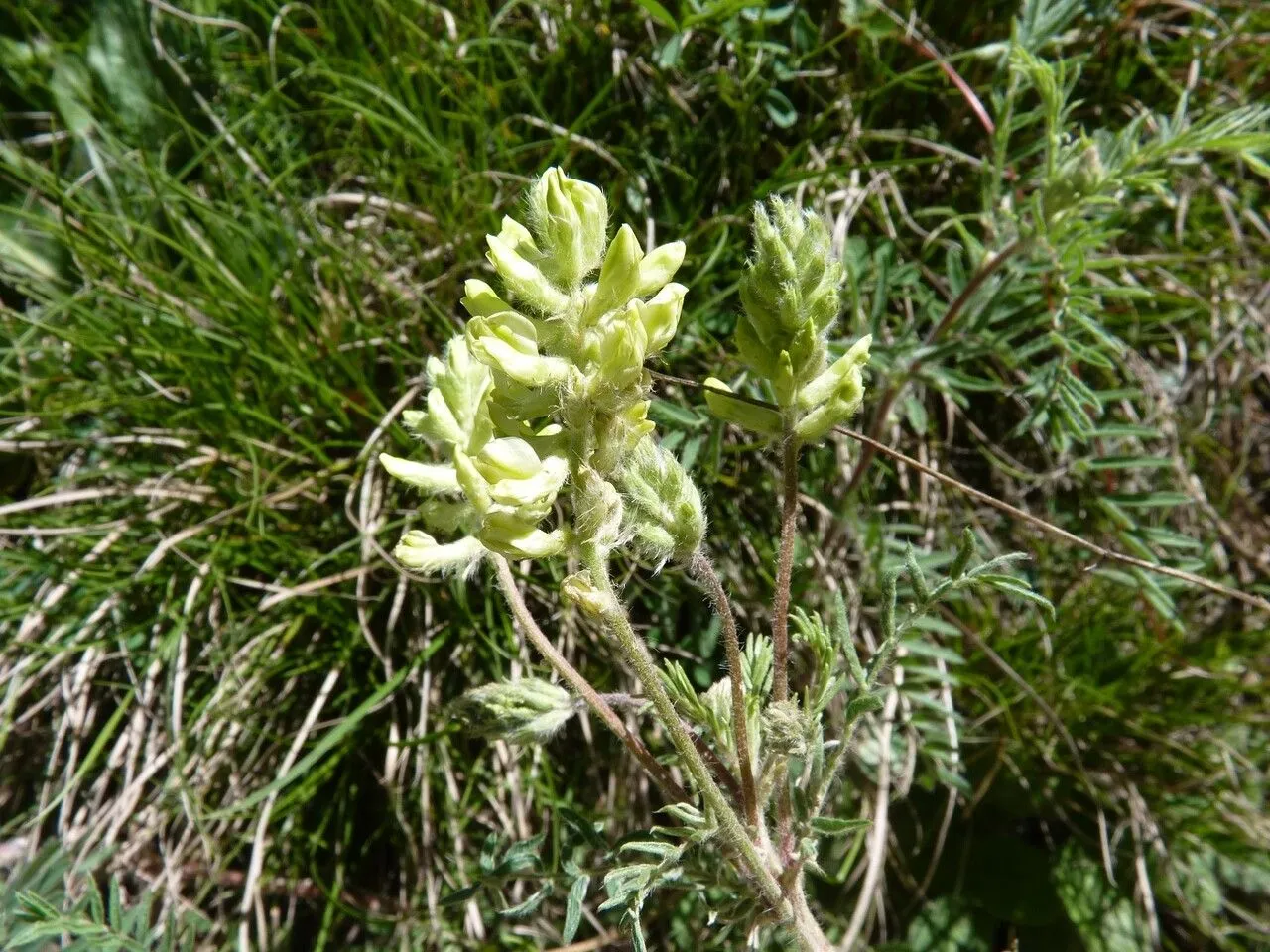
Author: (L.) DC.
Bibliography: Astragalogia: 91 (1802)
Year: 1802
Status: accepted
Rank: species
Genus: Oxytropis
Vegetable: False
Observations: Europe to Siberia and NW. Iran
Downy-beaked oxytropis, scientifically known as Oxytropis pilosa, is a flowering plant that belongs to the Fabaceae family, which is often referred to as the legume, pea, or bean family. This species is notable for its soft, downy appearance, which gives rise to its common name.
The plant exhibits a geographic distribution that spans from Europe across to Siberia, extending its presence to the northwest regions of Iran. This extensive range indicates the plant’s adaptability to diverse climatic conditions and various types of soil, making it a resilient species within its native habitats.
First described scientifically in a botanical reference titled Astragalogia in 1802, the taxonomy of Oxytropis pilosa was further refined and classified by the eminent botanist (L.) DC. This historical context underlines the plant’s significance and recognition in the botanical studies over centuries.
Oxytropis pilosa is an essential member of the Fabaceae family, contributing to the ecological balance through its role in nitrogen fixation—a common characteristic of legumes—which enriches the soil and supports surrounding plant life. This plant’s evolutionary features illustrate a remarkable adaptation strategy, showcasing traits such as its distinctively pilose, or hairy, structure that aids in water retention and protection from herbivores and harsh environmental conditions.
New buds of the Downy-beaked oxytropis emerge in a striking configuration, often displaying clusters of vibrant flowers that can range in color and contribute to the visual diversity of their natural landscapes. These flowering patterns not only enhance the aesthetic value of their regions but also serve as vital sources of nectar for various pollinators, including bees and butterflies.
Overall, the Downy-beaked oxytropis holds an important ecological niche and bears cultural and scientific importance due to its widespread presence and historical documentation. Analyses and ongoing studies of Oxytropis pilosa continue to shed light on its ecological roles, evolutionary biology, and potential uses within sustainable agriculture and horticulture.
Deu: steppen-fahnenwicke, zottige fahnenwicke
Swe: luddvedel
Lav: pūkain
Nno: lodnemjelt
Nob: lodnemjelt
En: Downy-beaked oxytropis, Hairy Milk-vetch
Be: Вастралодачнік валасісты
Zh: 疏毛棘豆
Cs: Vlnice chlupatá
Nl: Wollige Hokjespleul
Et: Karvane lipphernes
Fi: Arokeulankärki
Fr: Oxytropis poilu
De: Gelbe Fahnenwicke, Steppen-Fahnenwicke, Steppen-Spitzkiel, Zottige Fahnenwicke, Zottiger Spitzkiel
Hu: Borzas csajkavirág
It: Astragalo peloso
Lv: Pūkain
Lt: Plaukuotasis drugišius
Nb: Lodnemjelt
Nn: Lodnemjelt
Pl: Ostrołódka kosmata
Sv: Luddvedel
© copyright of the Board of Trustees of the Royal Botanic Gardens, Kew.
© copyright of the Board of Trustees of the Royal Botanic Gardens, Kew.
Taken May 15, 2014 by Tela Botanica − Françoise DUMAS (cc-by-sa)
Taken Jan 1, 1800 by Tela Botanica − Thierry Pernot (cc-by-sa)
Taken Jun 2, 2021 by Simon Tamás (cc-by-sa)
Taken Jun 7, 2017 by huy HO (cc-by-sa)
Taken Jan 1, 1800 by Tela Botanica − Thierry Pernot (cc-by-sa)
Taken Jul 15, 1987 by Photoflora – Jean-Luc TASSET (©)
Taken Jul 15, 2005 by Photoflora – Jean-Luc TASSET (©)
Taken May 15, 1997 by Photoflora – Benoit BOCK (©)
Taken Jun 7, 2017 by huy HO (cc-by-sa)
Taken Jan 1, 1800 by Tela Botanica − Thierry Pernot (cc-by-sa)
Taken Sep 21, 2021 by Hana Kuchaříková (cc-by-sa)
Taken Jun 6, 2021 by Jean Breton (cc-by-sa)
Taken Jan 1, 1800 by Tela Botanica − Thierry Pernot (cc-by-sa)
Taken Jun 2, 2021 by Simon Tamás (cc-by-sa)
Taken Jan 1, 1800 by Tela Botanica − Thierry Pernot (cc-by-sa)
Taken Jun 7, 2017 by huy HO (cc-by-sa)
Taken Jun 21, 2019 by MICHEL DUSSERE (cc-by-sa)
Taken May 15, 2007 by Photoflora – Benoit BOCK (©)
Taken Jul 15, 2020 by Giode Tonpino (cc-by-sa)
Taken Aug 15, 2012 by Photoflora – Benoit BOCK (©)
Taken Aug 15, 2012 by Photoflora – Benoit BOCK (©)
Taken Jan 1, 1970 by Photoflora – L’Abbé COSTE (©)
Taken Jul 15, 2007 by Photoflora – Benoit BOCK (©)
Taken Aug 15, 2017 by Photoflora – Jean-Luc TASSET (©)
Taken May 15, 2007 by Photoflora – Benoit BOCK (©)
Taken May 15, 2007 by Photoflora – Benoit BOCK (©)
Taken May 15, 2007 by Photoflora – Benoit BOCK (©)
Taken Jul 15, 2005 by Photoflora – Jean-Luc TASSET (©)
Family: Myrtaceae Author: (F.Muell.) K.D.Hill & L.A.S.Johnson Bibliography: Telopea 6: 402 (1995) Year: 1995 Status:…
Family: Rubiaceae Author: Pierre ex A.Froehner Bibliography: Notizbl. Bot. Gart. Berlin-Dahlem 1: 237 (1897) Year:…
Family: Sapindaceae Author: Koidz. Bibliography: J. Coll. Sci. Imp. Univ. Tokyo 32(1): 38 (1911) Year:…
Family: Asteraceae Author: A.Gray Bibliography: Pacif. Railr. Rep.: 107 (1857) Year: 1857 Status: accepted Rank:…
Family: Fabaceae Author: Medik. Bibliography: Vorles. Churpfälz. Phys.-Ökon. Ges. 2: 398 (1787) Year: 1787 Status:…
Family: Aspleniaceae Author: (Cav.) Alston Bibliography: Bull. Misc. Inform. Kew 1932: 309 (1932) Year: 1932…